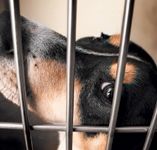San Antonio veterinary hospital, kennel battle canine influenza outbreak
About 30 cases of H3N8 canine influenza were confirmed and 60 others were suspected.
SAN ANTONIO — "This just spread like wildfire," says veterinarian Michele Wright of Huebner Oaks Veterinary Hospital.
In fact, Wright was referring to a recent outbreak of canine influenza, a highly contagious respiratory disease of dogs that swept through a local clinic and ultimately spread to a large dog kennel.

Caging in a virus: A San Antonio clinic had to take strong measures to stop the spread of a canine influenza outbreak.
In total, Wright tells DVM Newsmagazine that they confirmed about 30 cases of H3N8 canine influenza and 60 others were suspected.
"This is the first time we have ever seen it," Wright says. "We check a lot, since it became a disease in the United States. We constantly take PCR samples (at this kennel facility). And we get a lot of dogs in from various places—overseas and United States. If they come in and are coughing, they are PCRed and put in isolation. It just happens that with this kind of flu, they are shedding it before showing symptoms, and that is what got us in a bind," she explains.
Canine influenza has been around for 40 years, but in 2004, a scientific investigation confirmed a mysterious respiratory illness affecting Greyhounds was actually caused by equine influenza A H3N8. The virus has since been recognized as a new "dog-specific lineage of H3N8," according to the Centers for Disease Control and Prevention.
Since its introduction into the canine population in 2004, the H3N8 virus has since been identified in 38 states, including Texas.
"I think the important thing is that when it gets in your facility, it is so contagious you have to practically shut down to clean so that you don't infect other dogs," Wright explains.
Out of all the cases of known and suspected canine influenza from this outbreak, only three of the dogs became very ill. One of sickest dogs was a clinic dog that had recently undergone a blood transfusion and, therefore, was more susceptible to disease. All of the animals recovered, Wright says.
In this case, she says, the hospital was not aggressive in vaccinating against the influenza strain, simply because they had not documented any cases prior to this outbreak.
Prevention was far easier than the cure, Wright adds.
While veterinarians successfully treated animals infected with the virus, it was an enormous undertaking of time and manpower to disinfect every corner of the hospital and kennel, Wright says.
"You want to make your staff hate you? Let me tell you, we had to suit up in plastic gear, and it was 106 degrees outside. We had to wear disposable gowns, gloves, hairnets and booties, and they were not happy. I got some pretty nasty looks, but that is okay, I gowned up, too. We sweated together," she says.
So, what's her message to other veterinarians?
"When it takes your clinic down, it becomes a big deal. When you have to call owners of dogs that just came in for an ear flush because it was aerosolized or was on your clothes, it's a big deal," Wright says.